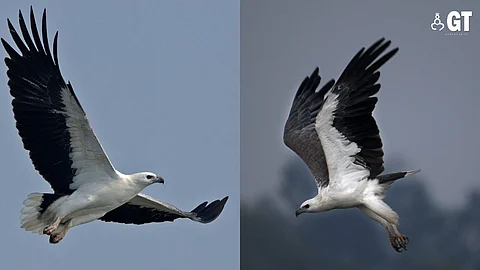

In a novel initiative called #FriendsOfTheEagle, Goa Bird Conservation Network (GBCN) volunteers have started identifying land owners willing to partner with them to conserve the nests of the white-bellied sea eagle, a majestic bird found in coastal habitats, including Goa.
Launched in October 2024, this conservation initiative, which involves identifying the nests of these birds, has made remarkable progress, successfully identifying 55 nesting sites across Goa’s coast.
A JOINT INITIATIVE
The white-bellied sea eagle is a unique bird, not only for its beauty, but also for its nesting habits, returning to the same nest to lay its eggs. Also, this striking bird is known for its monogamous nature, forming life-long bonds with a single mate.
The important initiative of identifying the nests is being implemented by the Mineral Foundation of Goa in collaboration with the GBCN, the Goa Forest Department and the Goa State Biodiversity Board.
It is funded by Persistent Foundation, an organisation committed to driving change through long-term transformative initiatives.
The important initiative of identifying the nests is being implemented by the Mineral Foundation of Goa in collaboration with the GBCN, the Goa Forest Department and the Goa State Biodiversity Board.
Professional birder and naturalist, Parag Rangnekar, who is part of the initiative, says, “Based on the data we have gathered since October 2024, many of the trees with white-bellied sea eagle nests are located in private properties. So, we are reaching out to these landowners, educating them on the importance of conserving these nests.”
Based on the data we have gathered since October 2024, many of the trees with white-bellied sea eagle nests are located in private properties.
Parag Rangnekar, Naturalist
LANDOWNERS JOIN FORCES
According to GBCN volunteers working on the ground, many landowners have shown genuine interest in contributing to the cause.
The idea behind the #FriendsOfTheEagle campaign is simple: Any landowner with a tree that hosts a white-bellied sea eagle nest, and who shows commitment to protecting it, will receive a ‘Certificate of Commitment’ from the Goa Forest Department and the Goa State Biodiversity Board.
This certificate serves as a recognition of a landowner’s pledge to safeguard the tree and the eagle’s nest.
Once a landowner becomes a friend of the eagle, they are trained, says Rangnekar, adding, “We will educate the landowners about the crucial conservation efforts such as ensuring there is no burning of waste within a 50-metre radius of the nest. This is important as the smoke can disturb the birds and their young.”
“Additionally, we’ll advise them against the use of LED lights near the nesting area, as artificial lighting can disorient the eagles and affect their natural behaviour. The goal of the training is to make sure the landowners are fully equipped with the knowledge to make informed decisions to preserve the natural habitats of these birds,” he adds.
The goal of the training is to make sure the landowners are fully equipped with the knowledge to make informed decisions to preserve the natural habitats of these birds.
Parag Rangnekar, Naturalist
FIRST CERTIFICATE OF COMMITMENT
At the concluding function of the recently held bird festival at Cotigao, in Canacona, the first ‘Certificate of Commitment’ was given to Taj Cidade de Goa Heritage in Dona Paula. The five-star property has a tree that hosts a white-bellied sea eagle nest.
By accepting the certificate, the resort has shown its commitment to wildlife conservation and set an inspiring example to other landowners and organisations to come forward to save the habitats of these birds and protect Goa’s rich biodiversity.
Rangnekar says that the work of identifying more white-bellied sea eagle nests will continue till the end of the breeding season, sometime in March or April.
“The most important part of our work is the ongoing research which will help us to understand the breeding biology of the white-bellied sea eagle. This includes gathering scientific data on the types of trees the eagles are nesting in, the height of these trees, and the girth of the trunks,” Rangnenkar says.
Rangnekar says that the work of identifying more white-bellied sea eagle nests will continue till the end of the breeding season, sometime in March or April.
CITIZEN SCIENCE MODEL
By collecting and analysing the data gathered since October 2024, GBCN aims to gain valuable insights into the birds’ nesting preferences and behaviour, which will strengthen the conservation efforts and help in the long-term protection of the species.
The most important part of the exercise is that the data isn’t just collected by researchers, but also by the local communities. The initiative is designed as a citizen science model.
TRAINING SESSIONS THAT MATTER
GBCN, which has around 200 members, has conducted training sessions for 40-plus coastal biodiversity management committees of the panchayats.
“Through this training, we are encouraging members of these committees to share information about where they’ve seen the white-bellied sea eagles and where their nests are located,” says a volunteer of GBCN. Also, avid birdwatchers and nature lovers from across the State are contributing to the inputs, he adds.
This unique initiative has the potential to make a significant impact on the conservation of the white-bellied sea eagle and increase the numbers of this magnificent bird.